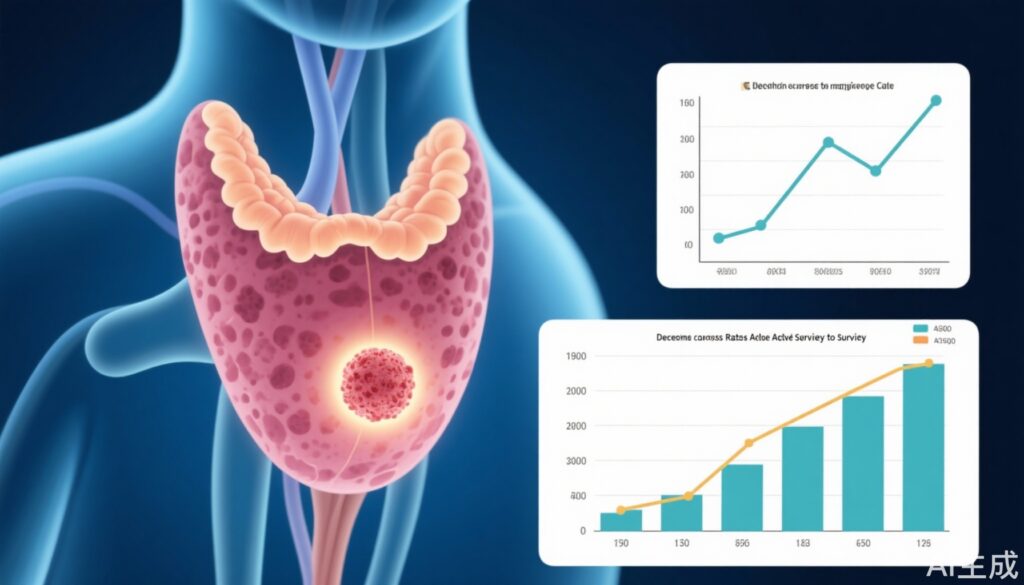Highlight
- Active surveillance (AS) is a effective long-term approach for managing small, low-risk papillary thyroid cancer (PTC).
- Older patients (≥65 years) demonstrate a markedly lower crossover rate to surgery compared to younger counterparts.
- Disease progression and patient preference are the primary reasons for crossover from AS to surgery.
- No thyroid cancer–related deaths or distant metastases occurred during long-term follow-up, underscoring the safety of AS.
Study Background and Disease Burden
Papillary thyroid cancer (PTC) is the most common form of thyroid cancer, frequently detected at an early stage owing to advances in imaging. Many PTCs under 2 cm in diameter carry a low risk of progression and mortality. Traditional management involves thyroid surgery, but this approach carries risks including hypothyroidism, recurrent laryngeal nerve injury, and lifelong hormone replacement therapy. Active surveillance (AS), entailing regular monitoring without immediate surgery, has emerged as an alternative strategy, aiming to reduce overtreatment and preserve quality of life. However, questions remain regarding the long-term durability of AS, particularly how age at the time of diagnosis influences outcomes and the likelihood of needing surgery later. Understanding these age-related dynamics is essential for personalized patient counseling and management.
Study Design
This prospective, single-center cohort study was conducted at a tertiary care hospital in Toronto, Ontario, Canada, involving 200 adult patients with localized, low-risk PTC tumors smaller than 2 cm. Patients were enrolled from May 2016 to February 2021 and followed until May 25, 2025, with data analysis completed in June 2025. Participants were offered a choice between AS or immediate thyroid surgery. The primary outcome was the crossover rate from AS to definitive treatment, including surgery initiated or recommended due to disease progression or patient preference. Age-stratified analyses examined incidence curves for crossover while considering death from other causes as competing risk. Data collection included ultrasound imaging and clinical evaluations, with median follow-up of 71 months.
Key Findings
Out of 200 patients, 155 initially chose AS, while 45 underwent immediate surgery. The patient cohort had a mean age of 52 years, with a majority being female (76.5%). Importantly, no thyroid cancer–related mortality or distant metastatic disease was reported over the follow-up period. Among those under AS, 23.9% (37/155) crossed over to definitive treatment—mainly surgery—due to various indications. Disease progression was the leading cause (56.8%), followed by patient preference (40.5%). In one case, technical limitations of ultrasound imaging in the context of Hashimoto thyroiditis complicated tumor monitoring.
Age significantly influenced crossover rates: the 5-year cumulative incidence of crossover was highest (41.5%) among patients younger than 45 years, intermediate (20.9%) in those aged 45–64 years, and lowest (5.1%) in patients 65 years or older (P < .001). These results indicate that older patients are less likely to transition from AS to surgery, suggesting AS is particularly durable and well-tolerated in this group.
The low crossover rate and absence of adverse cancer outcomes support the safety profile of AS for small, low-risk PTC, emphasizing its potential as a long-term management strategy, particularly for older adults. The study also highlights the importance of individualized patient counseling regarding AS durability and risks, tailored to patient age and preferences.
Expert Commentary
This Canadian cohort study represents one of the longest and most comprehensive follow-ups evaluating AS in PTC across an age-diverse population. Its findings reinforce evolving clinical guidelines that endorse AS as a viable option for selected low-risk thyroid cancers, especially for older patients who may benefit from avoiding surgical morbidity.
However, the study is single-center and may reflect specific local expertise and patient selection criteria. Larger multi-center trials could further validate these outcomes. Additionally, patients younger than 45 showed higher crossover, underscoring the need for vigilant monitoring and perhaps more nuanced age-specific counseling and risk stratification.
Mechanistically, the indolent biology of small PTC tumors likely contributes to the low progression rates, which may be further modulated by age-related tumor biology and immune responses. Improved imaging techniques could reduce uncertainty in tumor assessment, particularly in patients with concomitant thyroiditis.
Conclusion
Active surveillance for small, low-risk papillary thyroid cancer demonstrates durable effectiveness with excellent long-term safety, supporting its integration as a management option. Age at diagnosis is a critical factor influencing the likelihood of crossover to surgery, with older individuals displaying notably higher durability of surveillance. Personalized shared decision-making that incorporates patient age, tumor characteristics, and patient preference remains pivotal in optimizing management strategies for early thyroid cancer.
References
Sawka AM, Ghai S, Rotstein L, Irish JC, Pasternak JD, Monteiro E, Chung J, Su J, Xu W, Esemezie AO, Jones JM, Gafni A, Baxter NN, Goldstein DP; Canadian Thyroid Cancer Active Surveillance Study Group (Greater Toronto Area). Long-Term Durability of Active Surveillance of Small, Low-Risk Papillary Thyroid Cancer. JAMA Surg. 2025 Aug 20:e252957. doi: 10.1001/jamasurg.2025.2957. Epub ahead of print. PMID: 40833769; PMCID: PMC12368792.


